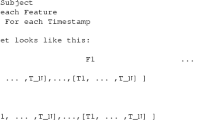Abstract
The Whitney embedding theorem gives an upper bound on the smallest embedding dimension of a manifold. If a data set lies on a manifold, a random projection into this reduced dimension will retain the manifold structure. Here we present an algorithm to find a projection that distorts the data as little as possible.
Similar content being viewed by others
References
D. S. Broomhead and M. Kirby, “A new approach to dimensionality reduction: Theory and algorithms,” SIAM J. Appl. Math. 60, 6 (2000), 2114–2142.
D. S. Broomhead and M. J. Kirby, “Dimensionality reduction using secant-based projection methods: The induced dynamics in projected systems,” Nonlinear Dyn. 41, 1 (2005), 47–67.
D. W. Dreisigmeyer, Equality constraints, Riemannian manifolds and direct search methods (2007). http://www.optimization-online.org/DBHTML/2007/08/1743.html.
D. W. Dreisigmeyer, “Direct search methods on reductive homogeneous spaces,” J. Optim. Theory Appl. 176, 3 (2018), 585–604.
A. Edelman, T. A. Arias, and S. T. Smith, “The geometry of algorithms with orthogonality constraints,” SIAM J. Matrix Anal. Appl. 20, 2 (1999), 303–353.
M. W. Hirsch, Differential Topology. Graduate Texts in Mathematics (Springer, New York, 1997).
Y. Lecun, L. Bottou, Y. Bengio, and P. Haffner, “Gradient-based learning applied to document recognition,”Proc. IEEE 86, 11 (1998), 2278–2324.
Author information
Authors and Affiliations
Corresponding author
Additional information
Any opinions and conclusions expressed herein are those of the author and do not necessarily represent the views of the U.S. Census Bureau. The research in this paper does not use any confidential Census Bureau information. This was authored by an employee of the US national government. As such, the Government retains a nonexclusive, royalty-free right to publish or reproduce this article, or to allow others to do so, for Government purposes only.
The article is published in the original.
David Wayne Dreisigmeyer was born in 1971. He graduated from Juniata College (BS in Pre-law, 1994) and Colorado State University (MS in Mathematics, 1999, and PhD in Electrical Engineering, 2004). He currently works at the United States Census Bureau’s Center for Economic Studies and as a Federal Data Strategy Fellow, and is the author of 8 papers. His scientific interests include uses of differential geometry in optimization and pattern analysis.
Rights and permissions
About this article
Cite this article
Dreisigmeyer, D.W. A Quasi-Isometric Embedding Algorithm. Pattern Recognit. Image Anal. 29, 280–283 (2019). https://doi.org/10.1134/S105466181902007X
Received:
Revised:
Accepted:
Published:
Issue Date:
DOI: https://doi.org/10.1134/S105466181902007X




